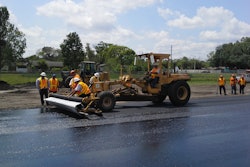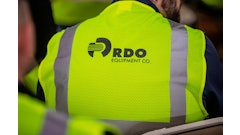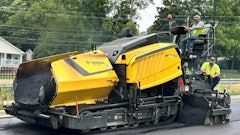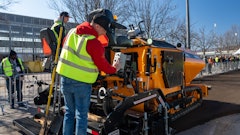
Asphalt Contractor magazine began publishing in 1986, and in the last three decades, there have been many changes to the equipment you use during your daily paving operations. In this article, we’re going to take a look at asphalt pavers and how they have evolved in the last 30 years to the machines we use today.
But first, a little walk through the history of asphalt pavers.
In 1876, President Grant paved the nation’s first street, Pennsylvania Avenue, on the north side of the White House. According to A Century of Progress: The History of Hot Mix Asphalt, published by National Asphalt Pavement Association, the president’s paving project covered about 54,000 square yards and used ‘Trinidad’ bitumen.
Early asphalt paving jobs were very labor intensive and, until the 1920s, the earliest items for laying asphalt could be easily transported by hand. These included brooms, lutes, squeegees and tampers.
Builders in the early 1920s would use modified Portland cement concrete mechanical spreaders for the first machine-laid asphalt. Later they added tailgate spreaders and concrete strike-off screeds.
On November 15, 1930, in Aurora, IL, Harry Barber made a sketch of a revolutionary new machine that would become the asphalt paver. Barber asked a patent attorney to come from Chicago and see this new machine, and so began the development of the modern asphalt paver.
Barber’s machine featured mixing and placing in a single operation and was exhibited for the first time at the 1931 Road Show in St. Louis. Barber realized that the mixing and placing operations needed to be separated and the mixing section became the line of Barber-Greene asphalt plants while the placing section became the Barber-Greene paver line.
Early pavers used screw conveyers to distribute the mix in front of a screed that tamped the mix, which was suitable for coarse-graded mixes, but on dense-graded mixes that were common on city streets, the machine experienced problems including surface imperfections.
In 1933, the independent floating screed was developed. This screed, along with the tamper bar that permitted uniform material density of the finished surface, were the two key features that allowed the machine to become successful. Early pavers had a hopper which material was dumped into and spread by an auger. The floating screed was supported on runners that travelled on the prepared base material.
Sheldon G. Hayes was the first to use a Barber-Greene finisher, which consisted of a tractor and screed unit with a vertical tamping bar.
Pavers added electronic leveling controls in the 1950s and automated screed controls in the early 1960s. Extra-wide finishers, capable of paving two lanes at once, debuted in 1968.
In 1987, one year after Asphalt Contractor magazine was born, the material transfer vehicle (MTV), which helped increase paver productivity, was introduced. [See box, “The Evolution of MTVs”]
A look back at the 1980s
According to our sources, the asphalt pavers you would find in the 1980s were very much the same as the ones you find today, yet so very different.
“In a lot of ways, pavers 30 years ago weren’t all that different from what they are today,” says Eric Baker, director of marketing and sales support with Roadtec. “The fundamental principles of the free-floating screed and tractor have not changed a lot. What has changed is the ease of operation, quality of pavement and smoothness and ease of maintenance.”
Jon Anderson, global sales and service consultant with Caterpillar – Paving Division, agrees. “The basic asphalt paver configuration was the same as it is today – wheel or track undercarriage, front loading hopper and floating screed,” he says. “Screeds were extendable with all the sloping and adjustments of today’s screeds, but most adjustments were done manually by hand cranks.”
“Mechanical” is a good term to describe most asphalt pavers in the 1980s. Pavers had mechanical gearbox drive systems, which required a lot of parts – gearbox, travel pumps and motors, drive shafts and drive chains.
“State-of-the-art pavers in the mid-80s were pavers evolving from linkages and chain/gear box drives to hydraulic and electro-hydraulic controls,” says Laikram ‘Nars’ Narsingh, manager, commercial support and development, for Vögele. “Propel systems were evolving for chain and sprocket drives to hydrostatic drives, while cylinder functions started to evolve from manual lever control valves to electric-over-hydraulic controls.”
Screeds of the time were predominantly fixed-width screeds. Width changes were made mechanically.
“You would have to build the screed to the width you were paving, and, if width changes were required, they weren’t on-the-fly like they are today with hydraulically extendible screed,” says Henry Polk, product marketing manager, paving products with BOMAG America. “Additionally, you could not set the auger height for the screed like you can today. This limited the paving depth, as the thicker the lift, the greater the chance it would be to create chevron patterns in the mat.”
Evolution via innovation
There have been many innovations for asphalt pavers over the last three decades that got them to where they are today. Our sources named the ones they felt were most important:
Direct hydraulic drive systems – Eliminated the complexity and service requirements of mechanical drive systems and created a more reliable, automated drive system for pavers that lowered operating costs.
Rear and front mounted hydraulically extendible screeds – By offering infinitely variable paving widths at the touch of button, these screeds increased paving flexibility for the contractor. No longer did they have to stop the paver to mechanically change paving widths.
Independently controlled feeder systems – This along with eliminating flow gates helped improve the homogeneity of the mix, which improved consistency and reduced segregation.
Automatic grade and slope systems with sonic grade sensors – These helped ensure the correct amount of mix reaches across the width of the screed.
Electric screeds – This screed technology eliminates the common smoky startups with diesel screeds and provides more uniform heat distribution across the entire screed bottom. It also gives screed operator more zonal control over screed temperature.
Rubber tracks – These gave the machine a more stable platform to make it easier to deliver smoother road surfaces and increased the travel speed of the unit.
“The most innovative changes in asphalt pavers in the last 30 years have been in the control systems and drive systems,” notes Narsingh with Vögele. “Electric over hydraulic controls, and most recently the CAN bus (a controller area network standard designed to allow microcontrollers and devices to communicate with each other in applications without a host computer), have provided infinite proportional speed changes in the paver propel and feeder systems.”
These types of controls allow contractors to maintain consistency of the forces that holds the screed to grade, says Narsingh. “Precise management of the paver speed, material delivery, screed extend and retract, and stopping and starting have significantly improved the quality of our pavements,” he says.
The last 30 years also saw the development of non-contact material controls. These allow the paver to automatically control just the right amount of materials to the front of the screed all the time.
“Our industry recognizes that poor head of material control is the leading cause of future mat failures,” says John Mooney, product specialist, Road Machinery with Volvo Construction Equipment. “Before these non-contact controllers, the material was either controlled by the screed operator or on/off switches. In both cases, the correction was only temporary causing a surge of material to catch up and leading to a high head of material to correct a low head of material.
“This up and down increasing decreasing material pressure in front of the screed caused many problems,” continues Mooney. “In addition, it was more difficult for the crew to maintain a constant head of material, paving speed and more difficult to pave straight edges as the surges pushed the floating screed from side to side.”
Driving trends
Innovations always happen for a reason, and there have been several trends in the asphalt road building industry over the last three decades that lead to the above paver innovations.
“So much more is known about the science of road building now than was prevalent in the 80s,” says Anderson with Caterpillar. “As federal agencies have gravitated toward performance-based contracts for paving work, contractors have recognized that safe, well-trained employees using advanced machinery gives them an edge that allows them to bid competitively and maximize awards. This has led to automation, simpler controls and features that optimize the mat in terms of reduced segregation and preparation for compaction.”
Mat quality has become increasingly important, so manufacturers wanted to make the operator’s job easier to allow him or her to focus on laying a good mat.
“The quest to improve mat quality, increase spec density and smoothness, and eliminate segregation have led to many of these paving innovations, as has the push to reduce maintenance costs, boost machine uptime and increase ROI,” says Bill Rieken, road building specialist at BOMAG America.
Since the late 90s, asphalt fume and engine exhaust emission standards have also driven paver design changes. “None of these changes have anything to do with making pavement,” says Narsingh with Vögele. “They provide an opportunity to include improvements that enhance the performance of the paver and working environment, however, which improves pavement quality.”
Baker with Roadtec agrees, noting that pavers have grown in size with the Tier 4 emission regulations. “The machine itself has gotten larger to incorporate the Tier 4 technology,” he says. “But they’re also much more efficient.”
Looking down the road
Asphalt pavers have come a long way in the last 30 years, but they haven’t stopped evolving. “Despite their complexity, paving machines are becoming simpler to operate with a high degree of proficiency,” says Anderson at Caterpillar.
Efficiency and quality paving will always move the bar when improving an asphalt paver, but issues like performance specifications replacing method specifications will give contractors more flexibility in selecting the type of equipment they use to meet these specifications for a particular project.
“The change by some DOTs from an equipment spec to an end-result spec will allow contractors to come up with the best, most cost-effective equipment solution to meet a required specification rather than using specific pieces of equipment in a paving train called out by the spec,” says Polk with BOMAG.
Temperature variation and smoothness specifications may drive contractors to start using more advanced technology to achieve results.
Indeed, thermal imaging and cloud-based systems are already driving innovation for improving temperature uniformity across the mat and giving contractors the opportunity for more intelligent paving systems to document results for back-up.
“Infrared imaging systems, like the MOBA IR thermal imaging scanner, give contractors not only the ability to see temperature across the mat, but it does so in real-time, so contractors can address thermal segregation issues by changing paving practices or adding pieces of equipment,” says Polk.
Some states, including Texas, Louisiana, Oklahoma and the province of Quebec, are already analyzing the temperature measurement at the back of the screed.
“We’ve known for a long time that uniform temperature is critical for uniform compaction, now there’s a way to measure it,” says Baker at Roadtec.
GPS- or total-station control of asphalt pavers is another recent development that we will see more of in the future. These technologies are appropriate for airports, large parking lots, new highway construction, and some mill-and-fill main line applications.
“Their growth was stifled over the past few years in the asphalt paving industry mainly because of the lack of 3D positioning data for the applications,” says Narsingh. “Also, supplying the data to the asphalt paver continuously and economically was a challenge. These challenges also made it difficult to find operators that are capable of using it.
“Now, improved satellite technologies – together with more economical availability of 3D positioning data – are driving improved machine control to utilize the 3D positioning data,” he says.
The Internet of Things
Technology will definitely drive the innovation of asphalt pavers over the next decade, predict sources.
“Technology that helps each part of the process (the plant, trucks, paving equipment, compactors) communicate with each other and optimize their efficiency,” says Anderson. “The paver needs to become a seamless part of a highly efficient process from plant to road surface.”
What he describes is the Internet of Things (IoT) – a network of physical objects, devices, vehicles, buildings and other items, embedded with electronics, software, sensors, and network connectivity that enables these objects to collect and exchange data.
“We envision a work site where all the equipment is sharing data,” says Baker. “For example, at the asphalt plant, how much tonnage was loaded in a truck? When that truck reaches the MTV, how many tons were delivered and how long did it take? What is the temperature consistency? At the paver, what is the real time laydown rate? How far did the last truck take us? Are we overrunning or underrunning? At the roller, are we getting density? How many passes is it taking us? All of this will be viewed in real time so quick adjustments can be made.”



![Lee Boy Facility 2025 17 Use[16]](https://img.forconstructionpros.com/mindful/acbm/workspaces/default/uploads/2025/09/leeboy-facility-2025-17-use16.AbONDzEzbV.jpg?auto=format%2Ccompress&fit=crop&h=100&q=70&w=100)


![[VIDEO] How ErgoPlus Operating Control System Works on Vogele Asphalt Pavers](https://img.forconstructionpros.com/files/base/acbm/fcp/image/2016/03/default.56fa92be7eae1.png?auto=format%2Ccompress&fit=crop&h=167&q=70&w=250)
![[VIDEO] Features of Carlson's CP75 Asphalt Paver](https://img.forconstructionpros.com/files/base/acbm/fcp/image/2016/03/default.56fa92784a3b3.png?auto=format%2Ccompress&fit=crop&h=167&q=70&w=250)



![Lee Boy Facility 2025 17 Use[16]](https://img.forconstructionpros.com/mindful/acbm/workspaces/default/uploads/2025/09/leeboy-facility-2025-17-use16.AbONDzEzbV.jpg?ar=16%3A9&auto=format%2Ccompress&fit=crop&h=135&q=70&w=240)







